Last Saturday, July 14th was eagerly anticipated on my part! The Sligo Field Club arranged a field trip to the Céide Fields in Ballycastle, Co. Mayo. For me, the Céide Fields are symnomous with its iconic visitor's centre, the image of which was reproduced on the Telecom Éireann calling cards in the nineties (if my memory serves me correctly?).
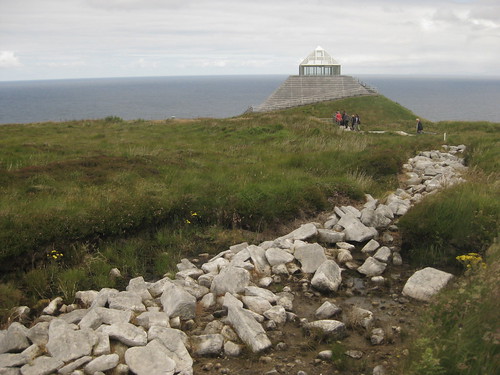
Remains of excavated stone wall can be seen in foreground. These would have been buried in up to 4 metres of peat, accumulated over thousands of years.
The visitor's centre, designed by Mary McKenna, is an acclaimed building, which received Ireland's most prestigious architectural award, the RIAI Triennial Gold Medal for 1992-1994, presented by the Royal Institute of the Architects of Ireland.
The pyramid shape was selected, as a unified peak growing out of the bog to form a natural extension of the landscape. The landscape and building join and are connected by the external steps.
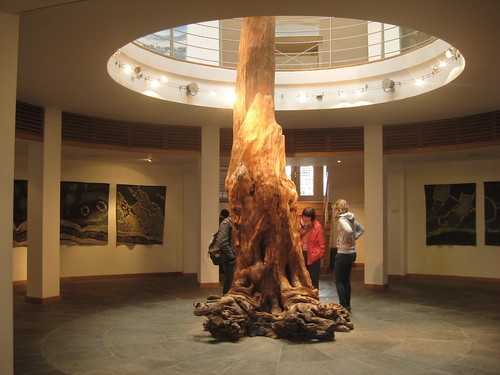
Upon entering the visitor's centre, this beautiful centrepiece is adjacent to the entrance, right at the base of the glass pyramid. It is a 4000 year old Scots Pine retrieved from the bog while it was being excavated in the 1970s.

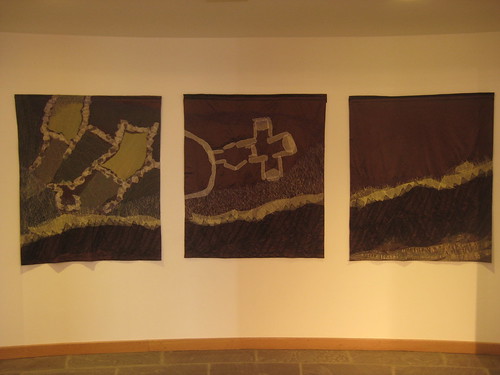
These silk banners are an artistic interpretation of the Céide Fields story. First we see the forest which came to the edge of the cliffs. The forest is felled and replaced by the stone walls, house enclosures and tombs of the Céide Fields farming community of 3000BC, before becoming enclosed in the peat* over thousands of years.
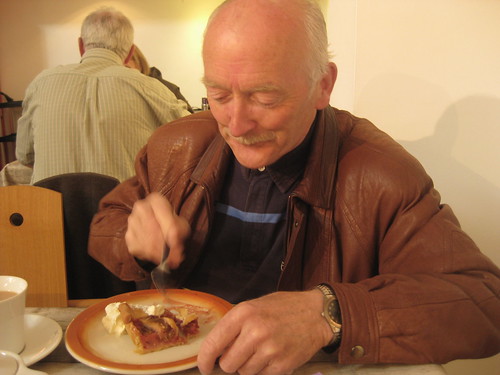
Dad started off the day by making a beeline for the café almost as soon as we arrived whilst I was still gazing in awe at the Scots Pine. Here he is enjoying a slice of rhubarb pie with cream, washed down with a pot of tae. The café is lovely, spacious with wonderful sturdy wooden seats and tables (covered in awesome "wood grain" oilcloth that fooled my Dad, har har). This is a small moot point but nothing spoils a great design more than those horrible grating plastic seats in museum/gallery cafés that are a horrid reminder of primary school/every soul destroying waiting room ever. There was a fluidity here that I felt really comfortable lounging in, even though I had no cake (one of my rare "I shall abstain" moments). In short, I always rate somewhere coupled with the merits of its bookshop/café.
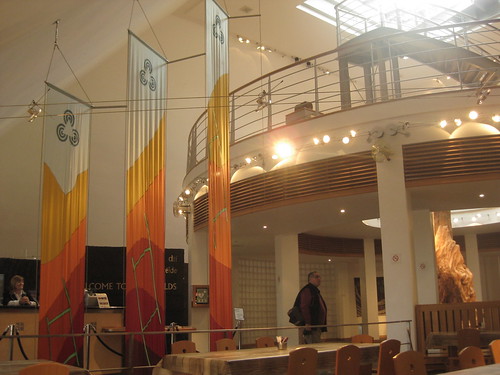
The interior of the centre is fresh and modern, hard to believe this is almost 20 years old, a mark of great design.
The centre and its interior are constructed from natural materials; sandstone, oak and glass, it was a combination of local work and resources initiated by a local archaeologist, Dr. Seamus Caulfield (Retired Associate Professor of Archaeology at UCD) and the Office of Public Works (OPW). The centre is one of over 60 Heritage Sites run by the OPW.

In 1989, Dr. Caulfield (then Professor at UCD) launched a project to build a visitor centre on the site which opened to the public in 1993. It was a fantastic privilege to have Dr. Caufield as our guide for the day. It was his late father, Padraig Caulfield who discovered the Céide Fields while cutting for turf* in the 1930s. Seamus went on to study archaeology and later excavated the site in the 1970s, with a team of archaeological students.
The Céide Fields are the oldest known field systems in the world, over five and a half millennia old. The remains of stone field walls, houses and megalithic tombs are preserved beneath a blanket of peat over several square miles.
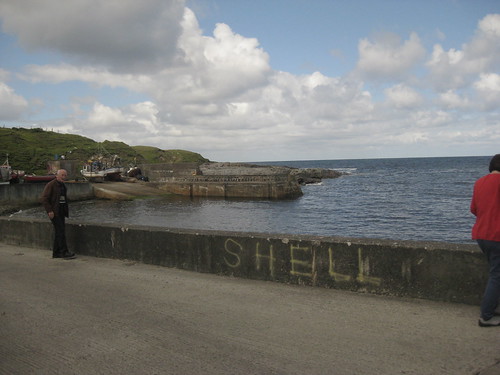
Recent Shell To Sea tensions are not forgotten in this historic landscape. Maud Gonne gave a speech here to the local farmers during the Republican Uprising, and stayed in the local hotel where we had our lunch - that had been a railway hotel at the time - built so to accomoate the expansion of the British Empire.
Dr. Caulfield took us to his village of Béal Deirg (anglicised as Belderg), a Gaeltacht village. The Céide Fields encompass Béal Deirg, where remains a pre-historic farming site, that we also visited. Seamus Heaney stayed with the Caufield's as a guest and conceived a poem inspired by the village and its history (the last of Heaney's bog poems, found in his book North published in 1975) -
Belderg
They just kept turning up
And were thought of as foreign'-
One-eyed and benign
They lie about his house,
Quernstones out of a bog.
To lift the lid of the peat
And find this pupil dreaming
Of neolithic wheat!
When he stripped off blanket bog
The soft-piles centuries
Fell open like a glib:
There were the first plough-marks,
The stone age fields, the tomb
Corbelled, turfed and chambered,
Floored with dry turf-coomb.
A landscape fossilized,
Its stone wall patterings
Repeated before our eyes
In the stone walls of Mayo...
Seamus reflected upon the complicated nature of his profession as an archaelogist - there are never any definite answers, each new discovery only raises more questions. One of the most pressing questions remains unanswered - Béal Deirg was a fishing community in pre-historic times, so what made them change to farming - was it a social or environmental cause?
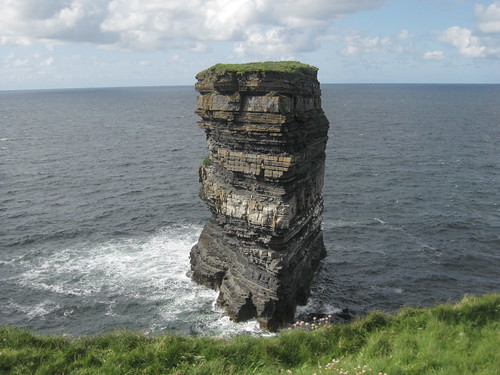
Dún Briste (The Broken Fort), a magnificent sea stack off Down Patrick Head (in the Atlantic Ocean) with evidence of medieval settlement. Seamus Caufield, along with a small group landed there via helicopter some years ago, the first people there for centuries.



The ruin above is the remains of a lookout post, used to watch out for enemy aircraft/boats in WW2, these were conceived to protect Ireland's neutrality during the War. These posts were manned by soldiers and the institution they formed was called the Coast Watching Service.
Seamus was a fascinating host, he had a rapt audience in us. You could acutely sense his passion for the landscape, his roots here and its pre-history. He made a particularly interesting comment on Cultural Heritage; the pattern of population distribution in Ireland has remained almost unchanged since pre-historic times, outside urban centres (and Ireland remains largely rural). A "village" is perhaps what with associate with Emmerdale, but in Irish terms it is a homeland, a number of houses scattered throughout a valley, they do not necessarily exist in a nucleated arrangement. Forced villagisation has been taken place only in the 19th and 20th centuries throughout some Western societies, and more recently in the developing world, often argued for due to the need for "protection". Such protection was unnecessary in the West of Ireland, due to the rough Atlantic Ocean on its side. Seamus described our cultural heritage as "Céide planning", as we continue to live in a similar arrangement to our Neolithic ancestors. He estimated that around a third of Irish people still live this way. Putting this unbroken legacy into perspective left me stunned and gave me goosebumps.
Another thing I found myself reflecting on afterward, was the question of the interpretive exhibit. It is the standard exhibit found in most museums, more often older regional museums with limited resources and funding. It is usually comprised of reconstructed living quarter, replete with museum mannequins and reconstructed living quarters, as well as artistic time scales. Seamus explained to us as he briefly lead us through this exhibit that due to the evolving nature of archaeology, new research constantly outdates the information presented here, which is now twenty years old. This is one of the difficulties of housing an archaeological museum, due to our ever advancing scientific knowledge, the limits of static exhibits becomes increasingly apparent. Can it therefore be called a museum, when a museum's purpose is to host artefacts, but for archaeological "artefacts" how can we preserve and how these when our knowledge of their use may change and evolve, and there are not the resources to constantly update whats there. Anyhow, that is a conversation for another day, and I do not have an archaeological degree. One of my good friends has worked at Knowth for a number of years so I'm sure we'll have this conversation over a bottle of wine at some point!
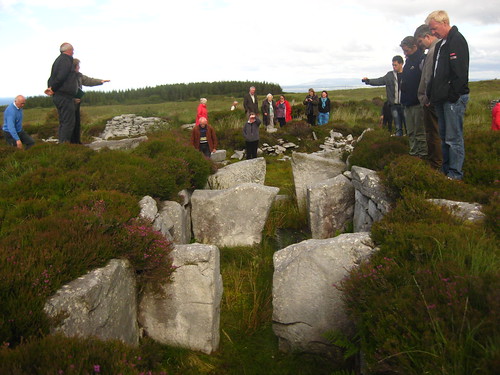
A snap of the group at the tomb excavated by Gretta Byrne, shortly after she completed her Masters field report on the area, in the 1970s. Gretta is currently Manager of Céide Fields Visitor Centre and Archaeological Site.
Seamus left us with these words: "If there's a car in the drive, knock on the door." (His house is by the small port I have pictured above). Which acurately summarizes his welcoming nature, he's an Irish gentleman, proud of his history.
* peat is a highly organic material found in marshy or damp regions, composed of partially decayed vegetable matter: it is cut and dried for use as fuel, known as "turf". It is a non renewable source of energy, a fossil fuel.
Details on opening hours and admission prices can be found here.

So. Interesting. What a wonderful blog entry! What jumped out at me was the curiousness of the people from Béal Deirg moving from fishing to farming. Made me think of travelling over to the Aran Islands: a place where the famine did not spread to because the people there, more used to fishing and living off the sea rather than the land, survived. This makes me lean more towards a social trend, but that's just based on a very general observation!
ReplyDeleteIs your Dad a member of the Sligo Field Club? It seems like a great organisation! Belfast has one too, but they mostly just do the Botanic Gardens and Cave Hill on repeat. Perhaps when my next bursary comes in, I might enrol for a few months though! :)